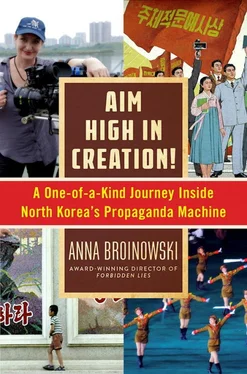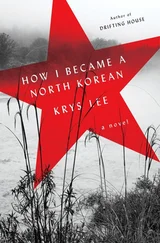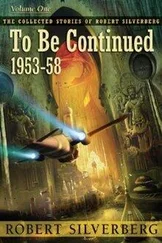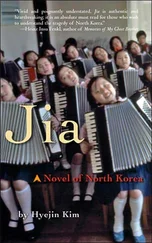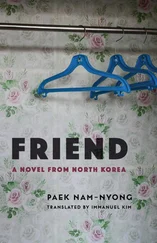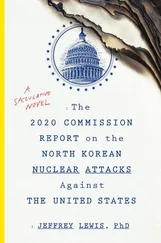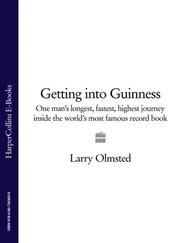We end the day with a tightly orchestrated ride on the subway. The entrance to Ponghwa Station is marked by a blazing portrait of a worker holding a Juche torch against the sky. The escalator ride down takes ten minutes: at 110 metres underground, the Pyongyang metro is one of the deepest in the world. It’s also a useful bomb shelter, should the Americans ever decide to attack. I’m sure Kim Il Sung had this in mind when he designed the metro in the late 1960s: for the three hundred to seven hundred thousand citizens using it daily, Ponghwa Station is a glorious reminder that they live in a socialist paradise worth fighting for. The platform is a magnificent gallery of propaganda art, with lavish mosaics of fighters, workers, and the Leaders, all lit by crystal chandeliers. It leaves the extravagant St. Petersburg metro for dead. The shiny red-and-green carriages of the Chollima line slide up, and we step inside a wood-panelled cabin with the obligatory Kims on the wall. The cabin guard, a stout woman in a black suit with gold epaulettes, studiously ignores us—along with all eighteen of her passengers.
Exactly one stop later, Q and Sun Hi hurry us out—doing nothing to dispel the rumours that the remaining stations, which foreigners never see, are miserable cesspits, with none of the splendour dazzling us now. We step onto the gleaming floor of Yonggwang Station: an even more spectacular celebration of all things Juche. The staircases are marble, the chandeliers are gold, and from every wall, enormous Kims smile at the tiny passengers from exquisite mosaics. People wander around in the museum-like calm, peering at glass-mounted copies of today’s Pyongyang Times.
In this web-free country, even the newsfeeds are works of art. Then the tranquillity is shattered by an explosion of laughter—as hundreds of children burst from the Chollima Line in a blur of red-and-blue sailor suits. They stream past us, lost in that chattering, school’s-out-for-the-day excitement common to kids all over the world, and the guards and office ladies step out of their way with indulgent smiles.
I stand next to Nic as she films the children surging up the staircase, fingering a little strip of celluloid in my pocket. I found it under a rose bush at the April 25 Military Film Studio. It contains three precious frames of a young soldier, his eyes full of defiant pride. The children run past our camera, bursting with curiosity and excitement. And I remember Mr. O’s words: Even in our country, the true revolutionary hero is the People. A leader isn’t necessary.
MONROE HAD A VOLUPTUOUS FIGURE
FORGET THE FARMERS AND WORKERS: NORTH Korean artists are number one. Tang Tap is a monument to this fact. From its huge base, a sickle, hammer, and pen rise on stone pillars, the pen soaring highest of all. Creatives have always been valued by totalitarian leaders: Stalin and Lenin believed cinema was the most powerful art of all; Hitler, an amateur painter, lavished resources on Albert Speer and Leni Riefenstahl; Mussolini knew that a book and a gun made the perfect fascist; and Saddam commissioned lavish biopics to promote his own mythology—before the war with Kuwait diverted his funds. But none of them managed to blur the line between dictator and artist as successfully as Kim Jong Il.
“A cameraman should be able to use small things to portray a great thing,” the Dear Leader wrote in his manifesto, and archival footage of Kim Jong Il expertly operating German film cameras shows he knew what he was talking about. Nic and I stand under the fifty-metre Tang Tap brush—a “small” thing the sculptors have managed to make truly great—and try to fit it into frame. The problem is, no matter what angle we film it from, it looks like a penis. The top is an elongated bulb, and the shaft is unapologetically phallic. We start to giggle. Q, curious, saunters over to check the viewfinder. Sun Hi is too horrified to translate, but Q knows why we’re laughing. “I’m sorry, Mr. Q, I just can’t fit it in,” I say, sending Nic into new paroxysms with my unintentional double entendre.
“Yes,” says Q pleasantly. It’s the only English word he knows.
We try panning around the brush to solve the problem—but this turns it into a gigantic revolving dildo. A hanboked guide floats up to recite her propaganda spiel, and I turn the camera on her with relief, wondering what Tang Tap’s Australian equivalent would be. Artists are seen as indulgent, taxpayer-sucking parasites in my sports-loving motherland. That’s unless they’re Kylie Minogue, Russell Crowe, Nicole Kidman, or some suburban crooner who’s made it big on The Voice . The Antipodean Tang Tap would have a beer can, barbeque tongs, and a cricket bat—with the beer can indisputably at the top.
“Our Dear Leader designed this monument to commemorate the Workers’ Party of Korea…” the guide starts to say—but Mr. Wang’s mobile phone rings. He drops his boom, lights a fag, and squats down to have a chat. I shrug at Nic. I’ve already explained to Mr. Wang that whenever Nic’s rolling, so is he, as our only source of audio. But Mr. Wang is proving extraordinarily dedicated to maintaining his social life.
Mobiles, surprisingly, are everywhere in Pyongyang. Until 2013, foreigners couldn’t take them in, but the locals have plenty. Sixty percent of the city’s 2.5 million citizens own a Nokia, Samsung, or smartphone clone, hooked up to 3G service Koryolink: a joint venture between Egyptian conglomerate Orascom and the Korea Post & Telecommunications Corporation. The phones are blocked from making international calls. As Mr. Wang chats and smokes, I watch people wandering around Tang Tap—reading books, waiting for buses, talking on their phones. The sun is shining and a pleasant breeze riffles the trees shading the square. Pyongyang would not be such a bad place to make movies, I decide, if you didn’t care about script control. When Kim Jong Il made Tang Tap’s brush higher than the hammer and sickle, he backed his symbolism with cash.
North Korea looks after its filmmakers assiduously, from the moment they enter the prestigious Pyongyang University of Film and TV. As students, they’re given access to Western films that ordinary North Koreans never see. When they graduate, they’re attached for life to one of Pyongyang’s five movie studios, installed in apartments, and put on permanent retainers. Female writers, editors, and actors are given free childcare to cope with the demanding hours. Cinematographers and directors are sent on overseas sabbaticals to improve their skills. Scriptwriters on deadlines are housed in the North Korean equivalent of luxurious Western script workshops like eQuinoxe: tranquil writing cottages in the country with twenty-four-hour catering and no distractions. “We are given preferential treatment,” actress Ms. Yun confirms. “The Party runs a special shop only for artists, so we can enjoy modern lifestyles. The shop provides us with everything from household goods to daily necessities. Thus, we can concentrate on making movies without any worries.”
Back when Kim Jong Il was in charge and flush with funds, filmmakers who did well, either locally or on the festival circuit, were given gold Rolexes, cars, and condominiums. Those who became People’s Artists never had to worry again. Ms. Yun is one of them: Kim installed her in a modern high-rise soon after she played the juvenile lead in Wolmi Island , and she now lives there with her children alongside famous musicians, playwrights, and opera stars. The artists are recognised wherever they go: “Often the fan mail is so high, it cannot fit under our beds,” Ms. Yun says shyly. She insists that nothing’s changed under Kim Jong Un, and that North Korea still produces thirty to forty feature films a year. The other filmmakers haven’t said anything to contradict her; but the rueful look in their eyes, when I ask what life was like before Kim Jong Il slashed their budgets in the 1990s to fund the army, suggests a different story.
Читать дальше
